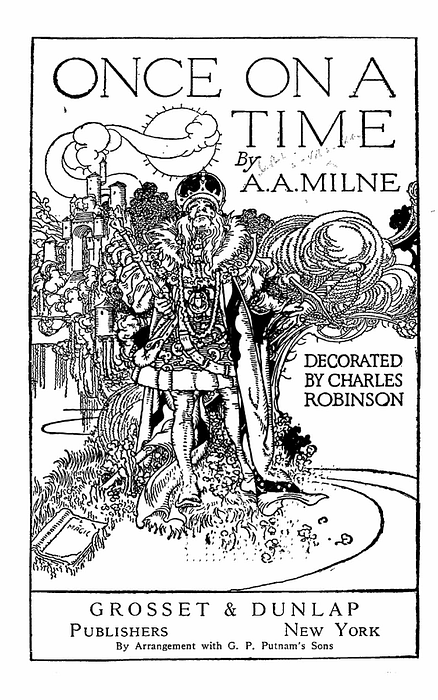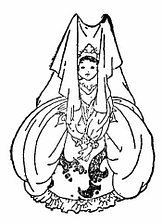ONCE ON A TIME
By
A.A. Milne
DECORATED BY CHARLES ROBINSON
GROSSET & DUNLAP
Publishers New York
By Arrangement with G. P. Putnam’s Sons

PREFACE
This book was written in 1915, for the amusement of my wife and myself at a time when life was not very amusing; it was published at the end of 1917; was reviewed, if at all, as one of a parcel, by some brisk uncle from the Tiny Tots Department; and died quietly, without seriously detracting from the interest which was being taken in the World War, then in progress.
It may be that the circumstances in which the book was written have made me unduly fond of it. When, as sometimes happens, I am introduced to a stranger who starts the conversation on the right lines by praising, however insincerely, my books, I always say, “But you have not read the best one.” Nine times out of ten it is so. The tenth takes a place in the family calendar; St. Michael or St. Agatha, as the case may be, a red-letter or black-letter saint, according to whether the book was bought or borrowed. But there are few such saints, and both my publisher and I have the feeling (so common to publishers and authors) that there ought to be more. So here comes the book again, in a new dress, with new decorations, yet much, as far as I am concerned, the same book, making the same appeal to me; but, let us hope, a new appeal, this time, to others.
For whom, then, is the book intended? That is the trouble. Unless I can say, “For those, young or old, who like the things which I like,” I find it difficult to answer. Is it a children’s book? Well, what do we mean by that? Is The Wind in the Willows a children’s book? Is Alice in Wonderland?Is Treasure Island? These are masterpieces which we read with pleasure as children, but with how much more pleasure when we are grown-up. In any case what do we mean by “children”? A boy of three, a girl of six, a boy of ten, a girl of fourteen—are they all to like the same thing? And is a book “suitable for a boy of twelve” any more likely to please a boy of twelve than a modern novel is likely to please a man of thirty-seven; even if the novel be described truly as “suitable for a man of thirty-seven”? I confess that I cannot grapple with these difficult problems.
But I am very sure of this: that no one can write a book which children will like, unless he write it for himself first. That being so, I shall say boldly that this is a story for grown-ups. How grown-up I did not realise until I received a letter from an unknown reader a few weeks after its first publication; a letter which said that he was delighted with my clever satires of the Kaiser, Mr. Lloyd George and Mr. Asquith, but he could not be sure which of the characters were meant to be Mr. Winston Churchill and Mr. Bonar Law. Would I tell him on the enclosed postcard? I replied that they were thinly disguised on the title-page as Messrs. Hodder & Stoughton. In fact, it is not that sort of book.
But, as you see, I am still finding it difficult to explain just what sort of book it is. Perhaps no explanation is necessary. Read in it what you like; read it to whomever you like; be of what age you like; it can only fall into one of two classes. Either you will enjoy it, or you won’t.
It is that sort of book.
-A. A. Milne.


